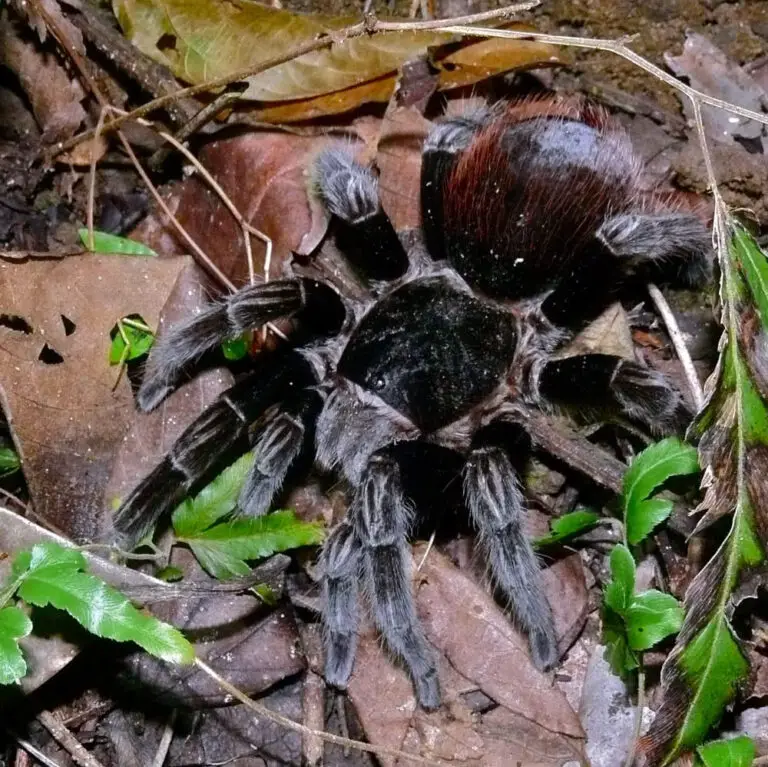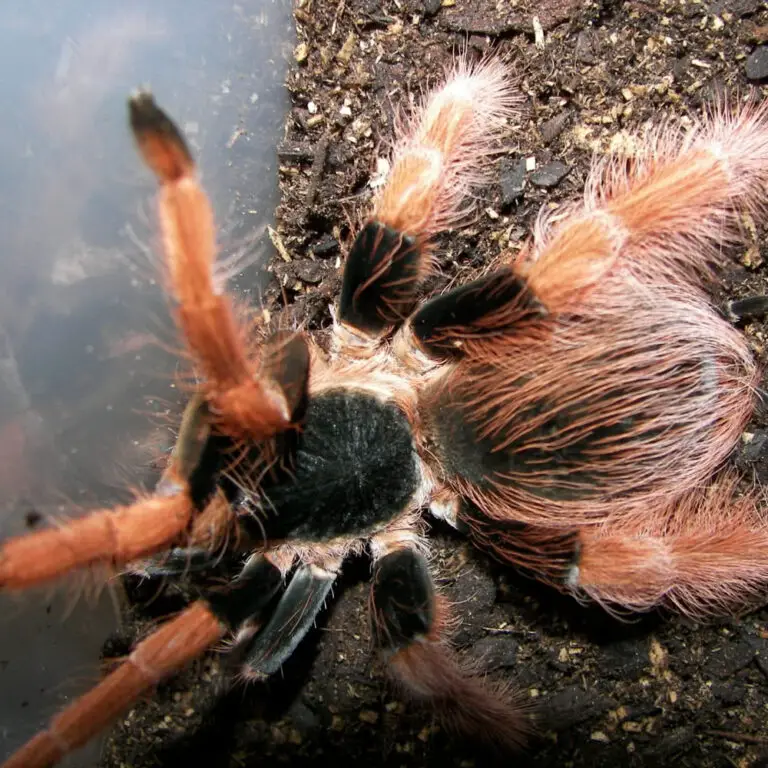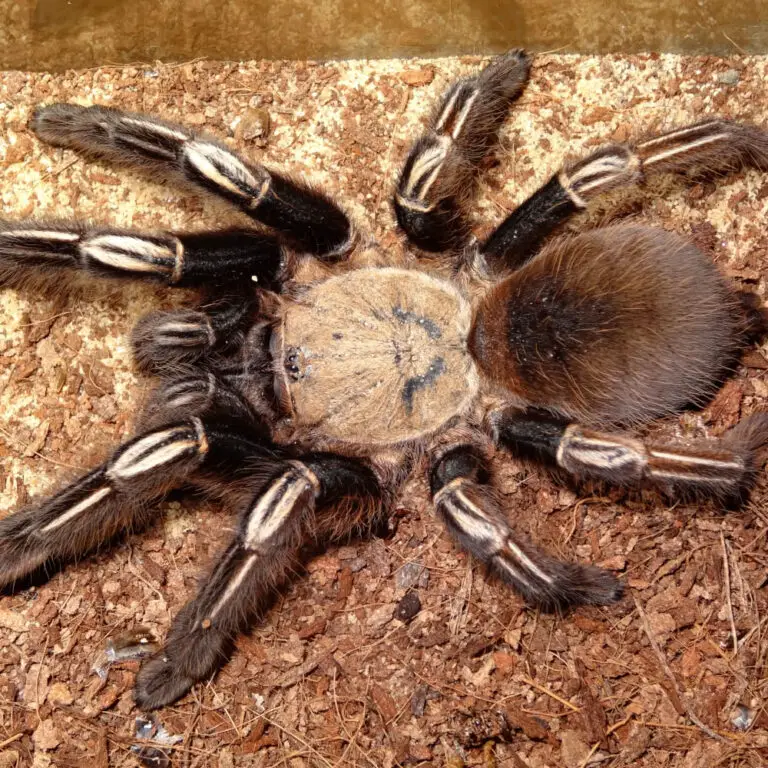The Texas Brown Tarantula, scientifically known as Aphonopelma hentzi, is a species of tarantula native to southern parts of the United States, particularly Texas, Oklahoma, Kansas, and Missouri. It is a large, docile tarantula with a unique set of characteristics and behaviors that make it a fascinating creature to study and keep as a pet.
Characteristics
The Texas Brown Tarantula is one of the largest tarantula species in North America, with a body length ranging from 2 to 2.5 inches and a leg span that can reach up to 5 inches. The coloration of the adults varies, with males typically having dark brown bodies and legs, while females are more reddish-brown in appearance. They have eight eyes arranged in two rows and fangs used for injecting venom into their prey.
These tarantulas have specialized hairs called urticating hairs on their abdomens. When threatened, they can kick these hairs into the air as a defense mechanism. These hairs can cause irritation to predators, including humans, causing discomfort and itching. Therefore, it is important to handle them with care and avoid contact with these hairs.
Behavior
The Texas Brown Tarantula is generally a calm and docile species. They prefer to avoid conflict and will retreat if given the opportunity. When threatened, their primary defense mechanism is to raise their front legs and expose their fangs as a warning. Biting is rare but may occur if they feel severely threatened or cornered. Their venom is not known to be dangerous to humans, but it can cause mild pain and swelling.
These tarantulas are mainly nocturnal, spending the day in burrows they dig themselves or seek out abandoned burrows or natural crevices. At night, they emerge to hunt for prey such as insects and small vertebrates. They are solitary creatures and only come together for breeding purposes.
Origin
The Texas Brown Tarantula is indigenous to the southern regions of the United States, particularly Texas, Oklahoma, Kansas, and Missouri. It is adapted to the dry, arid climate of these regions and can be found in grasslands, prairies, and scrublands.
Natural Habitat
The natural habitat of the Texas Brown Tarantula is diverse, ranging from deserts and grasslands to forests and scrublands. They can be found in a variety of habitats, including open plains, rocky areas, and burrows. These tarantulas dig burrows using their fangs and legs, creating tunnels that provide protection from predators and extreme weather conditions.
They are often found in areas with loose soil or sandy substrate, as it allows them to dig more easily. The burrows can extend several feet underground and have a webbed entrance to detect prey and intruders. These tarantulas also construct silk-lined chambers within their burrows for molting, mating, and resting.
Care
Keeping a Texas Brown Tarantula as a pet requires careful consideration and attention to their specific needs. It is essential to provide them with an appropriate enclosure that mimics their natural habitat. A terrarium with a secure lid and sufficient ventilation is recommended. The size of the enclosure should be suitable for the tarantula’s size, providing enough space for them to move around and create burrows.
The substrate in the enclosure should consist of a mixture of coconut fiber and potting soil, providing a moist environment while allowing for proper drainage. Decorations such as rocks, bark, and fake plants can be added to create a more naturalistic habitat. Temperature and humidity should be maintained within the recommended range, typically around 70-85°F with a humidity level of around 60-70%.
Feeding tarantulas requires providing them with a diet of live insects, such as crickets, cockroaches, and mealworms. The size of the prey should be suitable for the tarantula’s size, and it is recommended to feed them 2-3 times a week. Fresh water should always be available in a shallow dish, and the enclosure should be cleaned regularly to maintain hygiene.
Health & Diseases
The Texas Brown Tarantula is generally a hardy species, but they can be susceptible to certain health issues if not provided with proper care. One common problem is dehydration, as they require a moist environment with access to fresh water. Insufficient humidity can lead to the tarantula losing its ability to molt successfully or developing respiratory problems.
Another common health issue is injury or trauma from falling or being dropped. Tarantulas are delicate creatures, and any fall or impact can result in serious injuries. It is important to handle them gently and with care to avoid causing harm.
When it comes to diseases, tarantulas can be affected by various parasites, fungi, or bacterial infections. Symptoms of illness may include lethargy, loss of appetite, changes in coloration, or abnormal behavior. If any signs of illness are observed, it is recommended to consult a veterinarian experienced in exotic animal care.
Diet and Feeding
The diet of the Texas Brown Tarantula primarily consists of insects and other small invertebrates. In the wild, they hunt for prey at night, using their keen sense of touch and sophisticated set of fangs to capture and immobilize their victims. They are opportunistic hunters and can consume a wide range of prey items, including crickets, grasshoppers, beetles, and small spiders.
When kept as pets, they can be fed live insects such as crickets or cockroaches. The size of the prey should be appropriate for the size of the tarantula. It is important to ensure that the prey is clean and free from pesticides or other harmful substances. Feeding should be done in a separate container to prevent any substrate from being ingested along with the prey.
Young tarantulas should be fed more frequently, typically 2-3 times a week, while adults can be fed once or twice a week. It is important not to overfeed, as this can lead to obesity and health problems. Water should always be available in a shallow dish or through misting the enclosure to maintain proper hydration.
Breeding
The breeding season for Texas Brown Tarantulas usually occurs from late summer to early fall. During this time, mature males will venture out in search of females, often covering long distances to find potential mates. The male initiates courtship by tapping on the female’s burrow or vibrating the ground nearby to signal his presence.
If the female is receptive, she may emerge from her burrow, and the male will approach her cautiously, using his pedipalps to transfer a sperm packet called a spermatophore. The female, once inseminated, stores the sperm for future egg fertilization. The male’s lifespan may end shortly after mating, as they often become the female’s next meal.
The female Texas Brown Tarantula constructs an egg sac from silk within her burrow. She guards and cares for the sac, ensuring that it remains protected from predators and environmental conditions. After a few weeks, the eggs will hatch into spiderlings, miniature versions of the adults. The spiderlings will remain with the female for a period of time before dispersing and beginning their independent lives.
Images
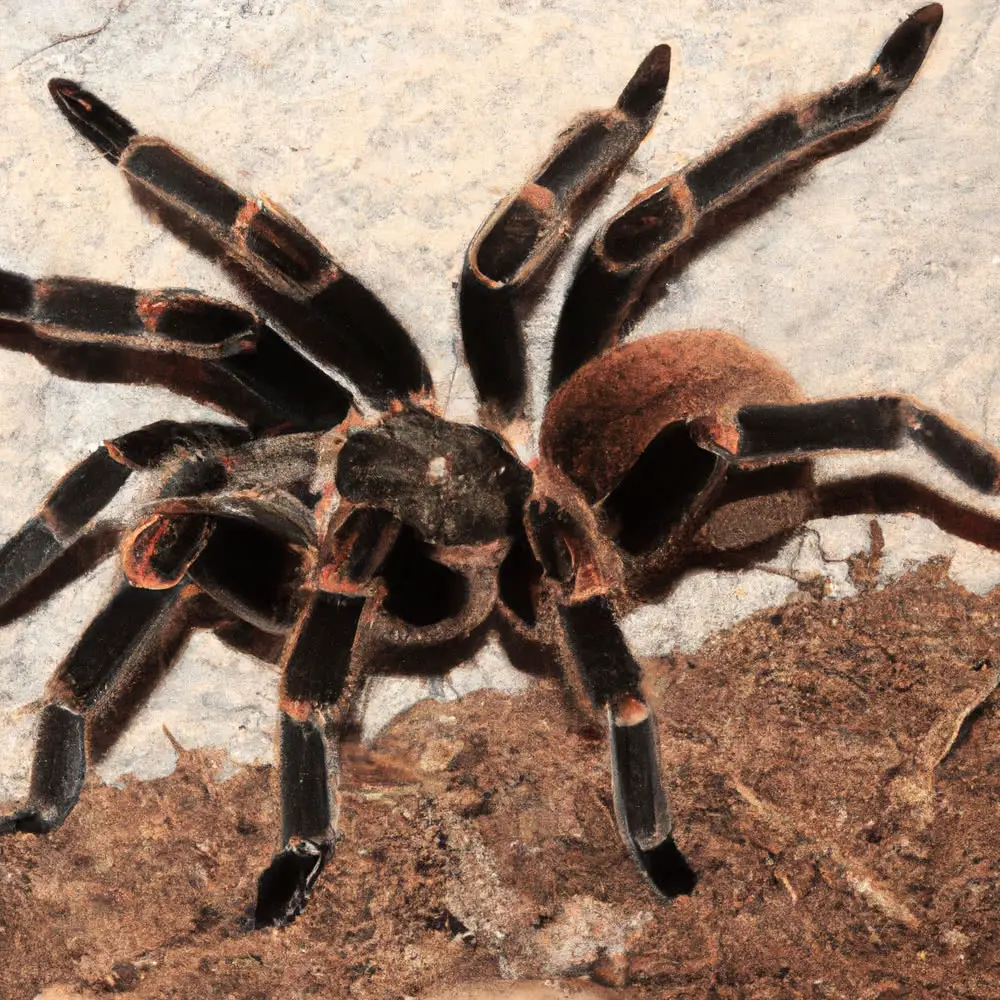
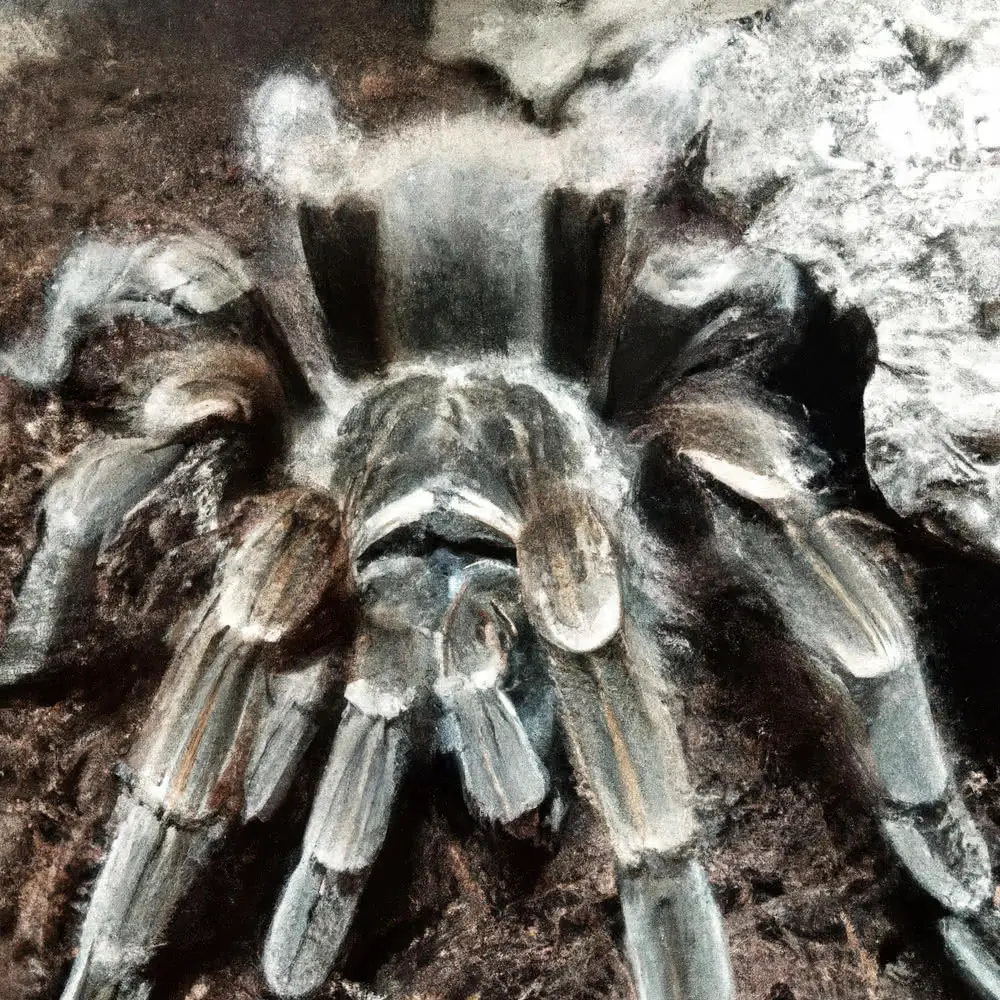
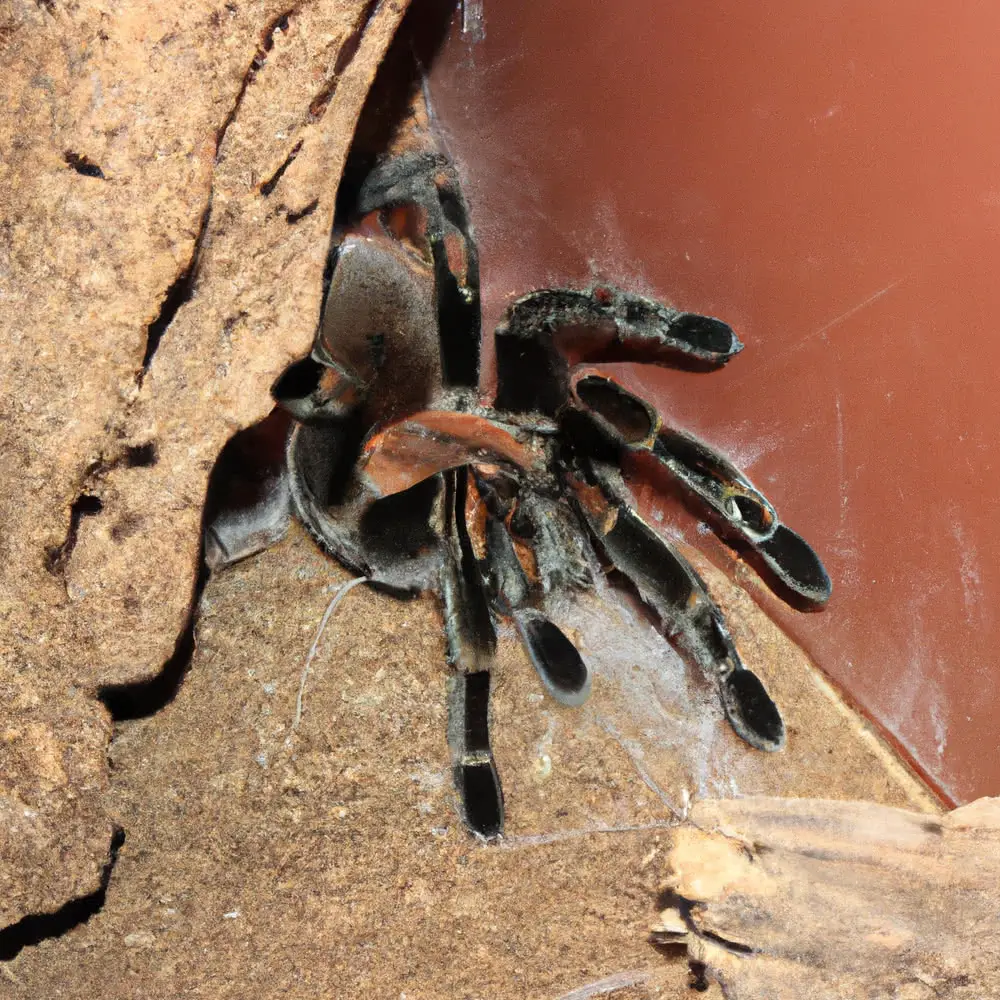
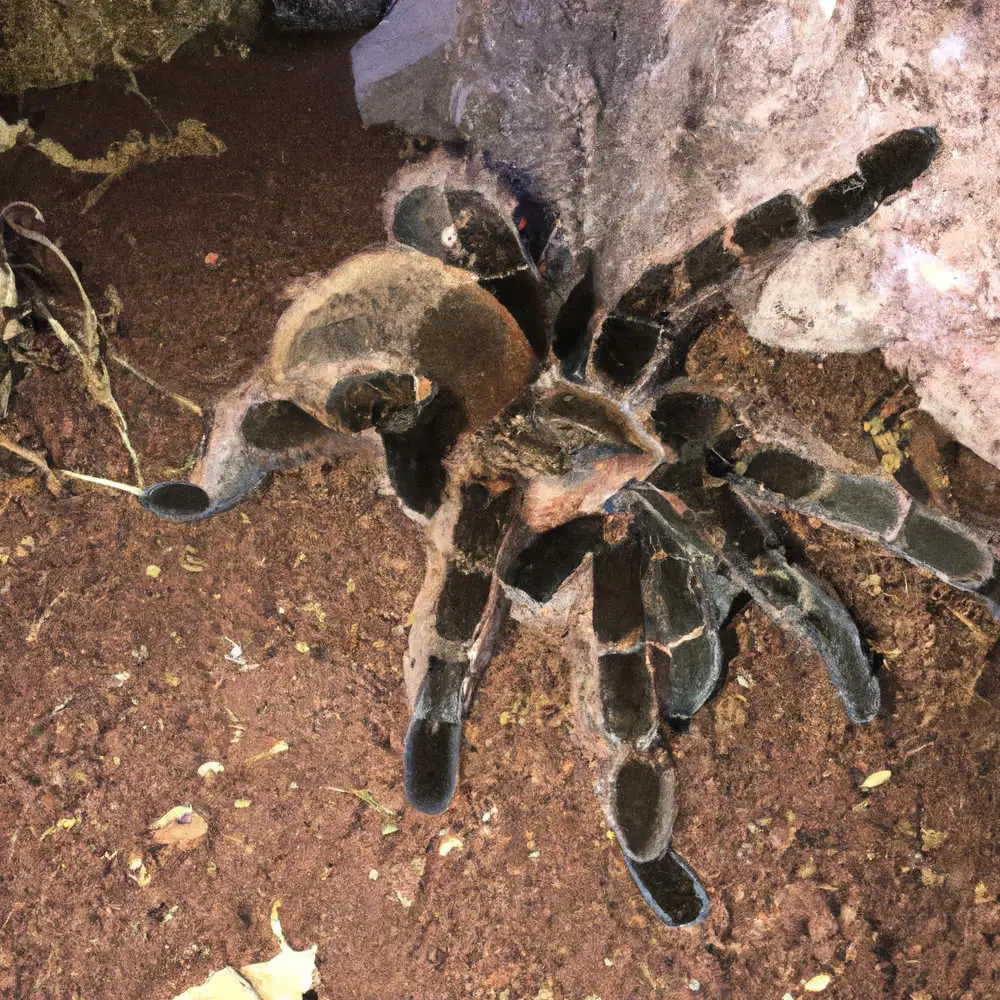
F.A.Q.
What is a Texas Brown Tarantula?
The Texas Brown Tarantula, also known as Aphonopelma hentzi, is a species of tarantula native to the southern United States, particularly Texas.
How big do Texas Brown Tarantulas get?
Adult Texas Brown Tarantulas can have a leg span of up to 5-6 inches and a body length of approximately 2-3 inches.
Where are Texas Brown Tarantulas found?
Texas Brown Tarantulas are primarily found in the southern United States, especially in the state of Texas. They inhabit grasslands, deserts, and scrubland areas.
Are Texas Brown Tarantulas venomous?
Yes, Texas Brown Tarantulas are venomous, but their venom is not considered dangerous to humans. Their venom is primarily used to immobilize and digest their prey.
How long do Texas Brown Tarantulas live?
Texas Brown Tarantulas have a lifespan of around 10-20 years in the wild. In captivity, they can live even longer, reaching up to 25 years or more.
What do Texas Brown Tarantulas eat?
Texas Brown Tarantulas are carnivorous and primarily feed on insects, such as crickets, grasshoppers, and beetles. They may also occasionally eat small reptiles or other small arachnids.
Are Texas Brown Tarantulas aggressive?
Texas Brown Tarantulas are generally not aggressive towards humans or other animals. They are docile creatures and will usually only bite if they feel threatened or cornered.
Can Texas Brown Tarantulas bite humans?
Yes, Texas Brown Tarantulas can bite humans if they feel threatened. However, their bites are not considered medically significant and usually cause only mild pain and swelling.
What should I do if I get bitten by a Texas Brown Tarantula?
If you get bitten by a Texas Brown Tarantula, you should clean the wound with soap and water, apply an antiseptic, and keep an eye on it for any signs of infection. If symptoms worsen or persist, seek medical attention.
Are Texas Brown Tarantulas nocturnal?
Yes, Texas Brown Tarantulas are primarily nocturnal creatures, meaning they are most active during the night. During the day, they tend to seek shelter in burrows or under rocks.
How can I identify a Texas Brown Tarantula?
Texas Brown Tarantulas have a dark brown or black body with a slightly velvety appearance. They have a stocky build, hairy legs, and a pattern of tan or reddish hairs on their abdomen.
Do Texas Brown Tarantulas have predators?
Yes, Texas Brown Tarantulas have several natural predators, including larger spiders, birds, lizards, and mammals such as raccoons and skunks.
Can Texas Brown Tarantulas swim?
Texas Brown Tarantulas are not adapted for swimming and are not known to do so willingly. They prefer dry environments and can drown if submerged in water for an extended period.
Do Texas Brown Tarantulas make webs?
While Texas Brown Tarantulas are capable of producing silk, they are not known for building extensive webs like some other species of spiders. They primarily use silk for lining their burrows.
Are Texas Brown Tarantulas social creatures?
No, Texas Brown Tarantulas are solitary creatures and do not typically interact or live in groups. They prefer to live and hunt alone.
Can Texas Brown Tarantulas regenerate lost limbs?
Yes, like many other tarantula species, Texas Brown Tarantulas have the ability to regenerate lost limbs through a process called molting.
How often do Texas Brown Tarantulas molt?
Texas Brown Tarantulas typically molt once or twice a year when they are young, but as they reach maturity, they molt less frequently, often only once every couple of years.
Why do Texas Brown Tarantulas molt?
Texas Brown Tarantulas molt in order to grow and shed their old exoskeleton. During this process, they also repair any damaged body parts and regenerate lost limbs.
How do Texas Brown Tarantulas reproduce?
Male Texas Brown Tarantulas use special hooks on their pedipalps to transfer sperm to the female during mating. The female then lays eggs, which she guards until they hatch.
Do male Texas Brown Tarantulas die after mating?
In some cases, male Texas Brown Tarantulas may die shortly after mating, especially if they are unable to escape the female’s grasp. However, this is not always the case, and some males may survive to mate again.
How many eggs does a Texas Brown Tarantula lay?
A female Texas Brown Tarantula can lay anywhere from a few dozen to a couple of hundred eggs, depending on various factors such as age and size.
How long does it take for Texas Brown Tarantula eggs to hatch?
The incubation period for Texas Brown Tarantula eggs is typically around 4-6 weeks, although it can vary depending on environmental conditions such as temperature and humidity.
What is the lifespan of a Texas Brown Tarantula in captivity?
In captivity, with proper care, Texas Brown Tarantulas can live up to 25 years or more, surpassing their average lifespan in the wild.
Can I keep a Texas Brown Tarantula as a pet?
Yes, Texas Brown Tarantulas can be kept as pets by experienced spider enthusiasts. However, they require specific care and should only be kept by those who are knowledgeable about their needs.
What kind of enclosure does a Texas Brown Tarantula need?
A Texas Brown Tarantula enclosure should be a securely lidded glass or acrylic tank with proper ventilation. It should be spacious enough for the tarantula to move and burrow, with appropriate substrate and hiding spots.
What should I feed my pet Texas Brown Tarantula?
Pet Texas Brown Tarantulas should be fed a diet of live insects, such as crickets, roaches, and mealworms. These insects should be appropriately sized and gut-loaded before being offered to the tarantula.
How often should I feed my pet Texas Brown Tarantula?
Adult Texas Brown Tarantulas typically only need to be fed once every 1-2 weeks. Juveniles may require more frequent feedings, while older tarantulas may eat less frequently.
How often should I clean the enclosure of a pet Texas Brown Tarantula?
The enclosure of a pet Texas Brown Tarantula should be spot-cleaned as needed to remove any leftover prey or waste. A full cleaning of the enclosure should be done every few months, replacing the substrate and cleaning any decorations.
Can I handle a pet Texas Brown Tarantula?
While Texas Brown Tarantulas are generally not aggressive, they are not considered handleable pets. They are delicate creatures and can easily become injured or stressed if mishandled.
What is the temperament of pet Texas Brown Tarantulas?
Pet Texas Brown Tarantulas are generally docile and calm, but they may become defensive or bite if they feel threatened or provoked. It’s best to observe them from a distance rather than attempting to handle them.
Do Texas Brown Tarantulas require any special care or attention?
Texas Brown Tarantulas require a stable and appropriate environment with adequate temperature, humidity, and substrate. Regular monitoring of their health, feeding, and molting is also important.
Can I house multiple Texas Brown Tarantulas together?
It is generally not recommended to house Texas Brown Tarantulas together, as they are solitary animals and may become aggressive towards each other. Keeping them separately helps prevent stress and potential injury.
How often should I mist the enclosure of a pet Texas Brown Tarantula?
While Texas Brown Tarantulas appreciate some humidity, they do not require regular misting. Providing a small water dish in the enclosure is usually sufficient to meet their moisture needs.
Can I add decorations or hiding spots to the enclosure of a pet Texas Brown Tarantula?
Yes, it is recommended to provide hiding spots such as bark, small logs, or artificial caves in the enclosure to mimic their natural habitat. Avoid using decorations with sharp edges that could harm the tarantula.
Are Texas Brown Tarantulas at risk of becoming endangered?
Currently, Texas Brown Tarantulas are not considered endangered. However, habitat loss and destruction, as well as collection for the pet trade, could potentially impact their populations in the future.
Are there any conservation efforts for Texas Brown Tarantulas?
Conservation efforts for Texas Brown Tarantulas primarily focus on preserving their natural habitats, educating the public about their importance, and promoting responsible collection and trade practices.
Can Texas Brown Tarantulas be kept in groups for breeding purposes?
Keeping Texas Brown Tarantulas in groups for breeding purposes is generally not recommended. Introducing male and female tarantulas can lead to aggression or cannibalism, unless carefully managed by experienced breeders.
Can Texas Brown Tarantulas be found in urban areas?
While Texas Brown Tarantulas primarily inhabit grasslands and desert areas, they can occasionally be found in urban areas, especially where suitable habitats exist such as gardens, parks, or undeveloped land.
How can I make my garden more attractive for Texas Brown Tarantulas?
To attract Texas Brown Tarantulas to your garden, you can provide suitable habitat elements such as rocks, logs, or tall grasses. Planting native plants that attract insects can also help create a suitable food source for the tarantulas.
Are Texas Brown Tarantula populations affected by climate change?
While no specific studies have been conducted on the impact of climate change on Texas Brown Tarantulas, climate change can potentially alter their habitat and disrupt their natural life cycles, which could have an impact on their populations.
How do Texas Brown Tarantulas defend themselves from predators?
Texas Brown Tarantulas have several defense mechanisms to protect themselves from predators. They can use their urticating hairs, flicking them into the air as a form of irritation or distraction. They can also bite or deliver venom in self-defense.
Are Texas Brown Tarantulas a protected species?
Texas Brown Tarantulas do not have protected status at the federal level in the United States. However, their status may vary at the state or local level, so it is important to check local regulations before collecting or keeping them.
What is the most effective way to capture Texas Brown Tarantulas for study?
The most effective way to capture Texas Brown Tarantulas for study is by using a clear container or jar and gently coaxing the tarantula inside. It is important to handle them with care and release them unharmed after observation.
Are Texas Brown Tarantulas commonly sold in the pet trade?
Yes, Texas Brown Tarantulas are one of the more common species of tarantulas sold in the pet trade due to their relatively calm temperament and availability in the wild. However, it is always recommended to source them from reputable breeders and suppliers.
Can Texas Brown Tarantulas live in arid conditions?
Yes, Texas Brown Tarantulas are adapted to arid conditions and can withstand high temperatures and low humidity. However, they still require access to water and appropriate moisture levels in their habitat.
How do Texas Brown Tarantulas communicate with each other?
Texas Brown Tarantulas communicate with each other primarily through chemical signals or pheromones. These chemical signals help them attract mates or communicate warnings to other nearby tarantulas.
Are there any known subspecies of the Texas Brown Tarantula?
The Texas Brown Tarantula, Aphonopelma hentzi, does not currently have any recognized subspecies. However, taxonomic revisions and further research may reveal additional variations in the future.
What is the average temperature range for Texas Brown Tarantulas?
Texas Brown Tarantulas are adapted to a range of temperatures but generally prefer a temperature range of 75-85°F (24-29°C). They can tolerate slightly higher or lower temperatures for short periods, but extreme temperatures should be avoided.
Can Texas Brown Tarantulas be found in other states besides Texas?
While Texas is their primary range, Texas Brown Tarantulas can also be found in other southwestern states of the United States, including Oklahoma, New Mexico, and Arizona.
How does the Texas Brown Tarantula contribute to its ecosystem?
The Texas Brown Tarantula contributes to its ecosystem by helping to control populations of insects and other small arthropods, which helps maintain balance within the ecosystem. Additionally, they provide food for some predators in the food chain.
Conclusions
The Texas Brown Tarantula is a fascinating and unique species of tarantula found in southern parts of the United States. With their large size, docile nature, and interesting behaviors, they have become popular among enthusiasts and pet keepers. Careful attention to their specific needs, such as proper housing, feeding, and health monitoring, ensures their well-being in captivity. As with any pet, it is important to educate oneself and provide a suitable environment to ensure the long-term health and happiness of these amazing creatures.

